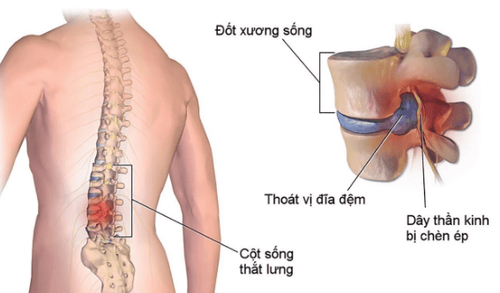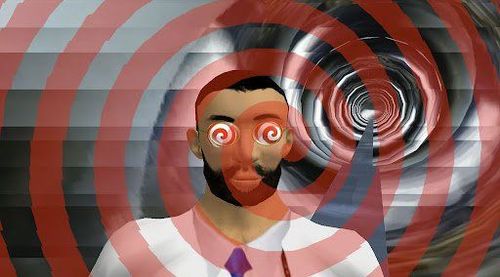This is an automatically translated article.
The article was professionally consulted with Master - Doctor Huynh An Thien - Department of Medical Examination and Internal Medicine, Vinmec Da Nang International General Hospital.Nerve root syndrome is a collection of problems that involve the spinal nerve roots. This condition often causes pain, numbness, or weakness in muscle groups depending on the location of the nerve roots. In which, the most common cause and location is due to compression and in the lumbar region.
1. What is nerve root syndrome?
A nerve root is an anatomical unit that refers to the beginning of a nerve as it leaves the central nervous system from the spinal cord. The types of nerve roots are classified from into the nerve category, including:The cranial nerve root is the first segment of each of the 12 pairs of cranial nerves when leaving the central nervous system from the brain stem or at the highest level of the spinal cord. The spinal nerve root is the first or proximal segment of one of the 31 pairs of nerves that leave the central nervous system from the spinal cord. Each nerve that exits the spinal cord is formed by the union of a sensory nerve root (afferent signal conduction) and a motor nerve root (efferent signal transduction). This means that there are 62 pairs of dorsal and ventral roots on both sides of the trunk. All lesions on the nerve roots belong to the nerve root syndrome. In particular, the common sign of nerve root syndrome is that it can cause paralysis of the muscles or sensory disturbances in the skin of the trunk at the position governed by the spinal nerves. Common causes of nerve root syndrome are compression, trauma, or effects of spinal tuberculosis, cancer, or spondyloarthritis.
Of these, the most common diagnosis of radiculopathy is sciatica. The first signs of the disease, which sometimes precede it for several years, are low back pain and tenderness, with numbness radiating down the legs.
Similar to nerve root syndromes in general, if sciatica is not detected and treated early, the pain greatly affects daily activities as well as psychology and quality of life. of the patient.

2. What are the signs of nerve root syndrome?
Because a pair of nerve roots contains two parts, a sensory (afferent) and a motor (efferent) nerve root, signs of radiculopathy will manifest. present at the same time is very diverse, including:Back pain, especially in the cervical spine or lumbar spine; Contractions of muscles; Decreased spinal mobility; Press with sharp pain points on the spine; The pain spreads along the nerve area at the distribution site.

3. Common signs of nerve root syndrome according to each location
3.1 Upper extremity nerve root syndrome
C5 nerve root: Pain at the site is found and radiates along the outside of the arm, weakening the muscles in the arm area. This distinguishes it from congenital muscle weakness that occurs in the deltoid, the oblique muscle. C6 nerve root: Pain is found along the anterior aspect of the affected arm, limiting pronation of the forearm. C7 nerve root: Pain is found along the middle finger of the affected arm, reducing the ability to flex the wrist and extend the finger.3.2 Lower extremity nerve root syndrome
Injuries in lower extremity nerve root syndrome not only cause muscle weakness and sensory disturbances in the lower extremities, but also cause symptoms of scoliosis, muscle spasms, and chronic low back pain.L4 nerve root: Pain is located in the front of the thigh and lower leg, continues to radiate to the inner ankle or sometimes the middle toe. Occasionally, the pain weakens the quadriceps and weakens the patellar reflex. L5 nerve root: Pain radiates to the side of the thigh and lower leg toward the back of the foot and toes 1-3. Fortunately, all reflexes are preserved. S1 nerve root: Pain radiates to the back of the thigh and at the lower leg to the ankle, sometimes up to the fourth toe. The result is also weakness of the gluteal muscles and difficulty standing on toes.
4. What causes nerve root syndrome and how is it diagnosed?
Nerve root syndrome can occur when nerve roots in the spine are irritated or pinched by one of the following conditions, such as herniated discs, spinal stenosis, spondylolisthesis, or spina bifida. Rarely, there are cases of intramedullary tumor or from outside causing insertion.The diagnosis of radiculopathy will begin with taking the history, findings, and physical examination. In it, the doctor will look for limitations of movement in the spine, problems with maintaining body balance as well as any loss of reflex presence in the extremities, muscle weakness, loss of sensation or Abnormal reflexes due to spinal cord origin.
In addition, imaging modalities also play a role in the diagnosis of radiculopathy. A straight X-ray to evaluate the posture and structure of the spine and magnetic resonance imaging to help evaluate the structure of the spinal cord and nerve roots are typical imaging tests used to investigate the disease. management in the spine in general, diagnosis of nerve root syndrome in particular. However, if the patient has contraindications to magnetic resonance imaging, computed tomography will be indicated instead.

5. How to treat nerve root syndrome?
Treatment modalities depend on the cause and stage of the disease, which are divided into two large groups:5.1 Non-surgical treatments
Physical therapy and/or exercises designed to stabilize the spine and open up exit space for nerve roots in the spine. This is essential in the acute phase, where the patient is instructed to do stretching and muscle relaxation exercises.Medicines, such as nonsteroidal anti-inflammatory drugs (NSAIDs) to reduce swelling and pain and analgesics to relieve pain.
Epidural steroid injections and nerve root injections to help reduce swelling and treat acute pain that radiates wide or down the leg.

5.2 Surgical interventions
Surgery is used when the above methods do not yield results. However, surgery is the first-line indication and should be performed as soon as possible in acute posttraumatic nerve root syndromes in order to avoid long-term irreversible muscle paralysis sequelae. long.The usual goal of surgical procedures is to find a way to decompress the nerve and stabilize the spine.
In a nutshell, radiculopathy are lesions that occur at the site of origin of the nerve exiting the spinal cord. Because the function of nerve roots is very important, receiving sensations and controlling movement in a large area of the body, it is necessary to find the cause and appropriate treatment to prevent sequelae of disability later on.
In order to achieve the best treatment effect, the time to detect the disease is very important, proportional to the treatment result. As soon as abnormal symptoms appear, you should immediately go to a reputable medical facility for early examination, diagnosis and treatment.
Vinmec International General Hospital is a high-quality medical facility in Vietnam, the doctors and nurses are all professionally trained, domestic & international, experienced, dedicated to patients. The system of modern and modern facilities and medical equipment is imported from the US, on par with major hospitals in the world.
Please dial HOTLINE for more information or register for an appointment HERE. Download MyVinmec app to make appointments faster and to manage your bookings easily.














